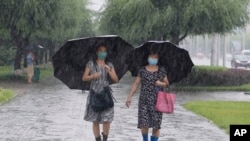Severe floods in North Korea have killed at least 22 people and left four others missing, according to the International Federation of Red Cross and Red Crescent Societies.
In a statement citing figures from North Korean officials, the IFRC said the floods have also caused widespread crop damage, intensifying economic concerns in a country that already suffers chronic food shortages.
The state-run Korean Central News Agency (KCNA) reported Friday that nearly 40,000 hectares of crops have been damaged and 17,000 houses destroyed or inundated.
“Lots of roads, bridges and railway sections (were) broken, a dam of a power station gave way and there was other severe damage in various sectors of the national economy,” the KCNA report said.
The Korean peninsula has seen a much longer than usual monsoon season. Parts of South Korea recently saw 49 consecutive days of rain, causing floods and landslides that killed dozens of people.
North Korea is particularly vulnerable to flooding. It lacks adequate infrastructure and suffers from widespread deforestation, which resulted in part from people cutting down trees for fuel or firewood or to clear land for farming.
The floods come as North Korea tries to prevent the spread of coronavirus. Last month, North Korea locked down an area around the southwestern city of Kaesong after warning that a defector from South Korea might have brought the virus across the border.
On Friday, KCNA reported that the Kaesong lockdown was lifted “based on the scientific verification and guarantee by a professional anti-epidemic organization.”
North Korea has reported no confirmed coronavirus cases, even as it carries out strict measures to keep the disease from spreading.
At a politburo meeting Thursday, North Korean leader Kim Jong Un indicated his country would not accept international aid for flood damage, due to coronavirus concerns.
“The situation, in which the spread of the worldwide malignant virus has become worse, requires us not to allow any outside aid for the flood damage but shut the border tighter and carry out strict anti-epidemic work,” Kim was quoted as saying.
According to the IFRC, North Korea’s Red Cross is providing relief to support 2,800 families, including family tents for people most at risk, tarpaulins, shelter tool kits, kitchen sets and quilts to help people with their urgent needs.
“DPRK Red Cross volunteers are also providing hygiene kits, water containers and water purification tablets, all while engaging in COVID-19 prevention activities,” the IFRC said.
South Korea has also offered help, partly in the hopes that such humanitarian assistance would help lead to renewed diplomatic engagement with North Korea. But Leif-Eric Easley, a professor at Ewha University in Seoul, said that now appears unlikely.
“Kim Jong Un’s public rejection of international aid for flood recovery, and his lifting a COVID-19 quarantine on the border city of Kaesong, are negative indicators for inter-Korean cooperation,” Easley said.
North Korea walked away from nuclear talks with the United States late last year. It has also ended almost every form of engagement with South Korea.
Despite its claim of being coronavirus-free, experts say the disease has likely reached North Korea’s borders. A major outbreak could be disastrous, since many areas of North Korea are impoverished and the country lacks adequate medical supplies and facilities.
North Korea formally closed its borders due to coronavirus concerns in late January, shortly after the outbreak was first reported in neighboring China. The lockdown has resulted in plummeting economic activity with China, North Korea’s biggest trading partner. That has put even more strain on an economy already held back by international sanctions.









